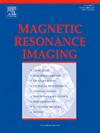Simultaneous acquisition of water, fat and velocity images using a phase-contrast 3p-Dixon method
IF 2
4区 医学
Q2 RADIOLOGY, NUCLEAR MEDICINE & MEDICAL IMAGING
引用次数: 0
Abstract
Purpose
Phase-contrast MRI (2D PC-MRI) and Dixon techniques share the characteristic that the difference in frequency between water and fat, as well as the velocity, are encoded in the phase of the MR signal. We propose to take advantage of this characteristic to obtain both sets of images simultaneously. Such an acquisition will improve efficiency by obtaining both types of images in the same scan and will provide co-registered images of water-fat species and velocity images. This, in turn, will correct fat artifacts due to chemical shift in PC-MRI based measurements.
Methods
This study presents a novel PC multi-echo (PCME-MRI) sequence jointly with a 3-point (3p-) Dixon pipeline that enables reconstruction of water, fat, and velocity images simultaneously. The proposed 3p-Dixon approach preserves the phase information of water-fat images, while velocity images are obtained from the resulting water components.
Results
Numerical phantom tests and 2D MR axial images of the neck acquired in 12 healthy volunteers demonstrated the feasibility of the PC 3p-Dixon method, showing comparable performance to standard techniques. In volunteers the median and range MAE comparing PC 3p-Dixon, and standard 3p-Dixon fat fraction were 0.06 and [0.03, 0.09]. The median and range of velocity for PC 3p-Dixon were 6.15 ml and [3.86, 7.21]ml, compared to 6.43 ml and [4.62, 8.27]ml obtained by 2D PC-MRI.
Conclusion
Numerical phantom experiments and acquisitions from healthy volunteers showed promising results in fat fraction and velocity estimation of PC 3p-Dixon compared with standard 3p-Dixon and 2D PC-MRI, obtaining both data sets in similar times as standard 3p Dixon.
使用相衬3p-Dixon方法同时获取水、脂肪和速度图像。
目的:相位对比MRI (2D PC-MRI)和Dixon技术的共同特点是,水和脂肪之间的频率差异以及速度都被编码在MR信号的相位中。我们建议利用这一特性同时获得两组图像。通过在同一次扫描中获得两种类型的图像,这种采集将提高效率,并将提供水-脂肪种类和速度图像的共同配准图像。反过来,这将纠正基于PC-MRI测量的化学位移造成的脂肪伪影。方法:本研究提出了一种新的PC多回声(PCME-MRI)序列,结合3点(3p-) Dixon管道,可以同时重建水、脂肪和速度图像。提出的3p-Dixon方法保留了水-脂肪图像的相位信息,同时从所得的水成分中获得速度图像。结果:12名健康志愿者的数值幻像测试和颈部二维MR轴向图像证明了PC 3p-Dixon方法的可行性,表现出与标准技术相当的性能。在志愿者中,比较PC 3p-Dixon脂肪分数和标准3p-Dixon脂肪分数的MAE中位数和范围分别为0.06和[0.03,0.09]。pcp3 - dixon的速度中位数和范围分别为6.15 ml和[3.86,7.21]ml,而2D PC- mri的速度中位数和范围分别为6.43 ml和[4.62,8.27]ml。结论:与标准3p-Dixon和2D PC- mri相比,从健康志愿者的数值模拟实验和获取的PC 3p-Dixon的脂肪含量和速度估计结果令人满意,获得的数据集与标准3p-Dixon的时间相似。
本文章由计算机程序翻译,如有差异,请以英文原文为准。
求助全文
约1分钟内获得全文
求助全文
来源期刊

Magnetic resonance imaging
医学-核医学
CiteScore
4.70
自引率
4.00%
发文量
194
审稿时长
83 days
期刊介绍:
Magnetic Resonance Imaging (MRI) is the first international multidisciplinary journal encompassing physical, life, and clinical science investigations as they relate to the development and use of magnetic resonance imaging. MRI is dedicated to both basic research, technological innovation and applications, providing a single forum for communication among radiologists, physicists, chemists, biochemists, biologists, engineers, internists, pathologists, physiologists, computer scientists, and mathematicians.
 求助内容:
求助内容: 应助结果提醒方式:
应助结果提醒方式:


